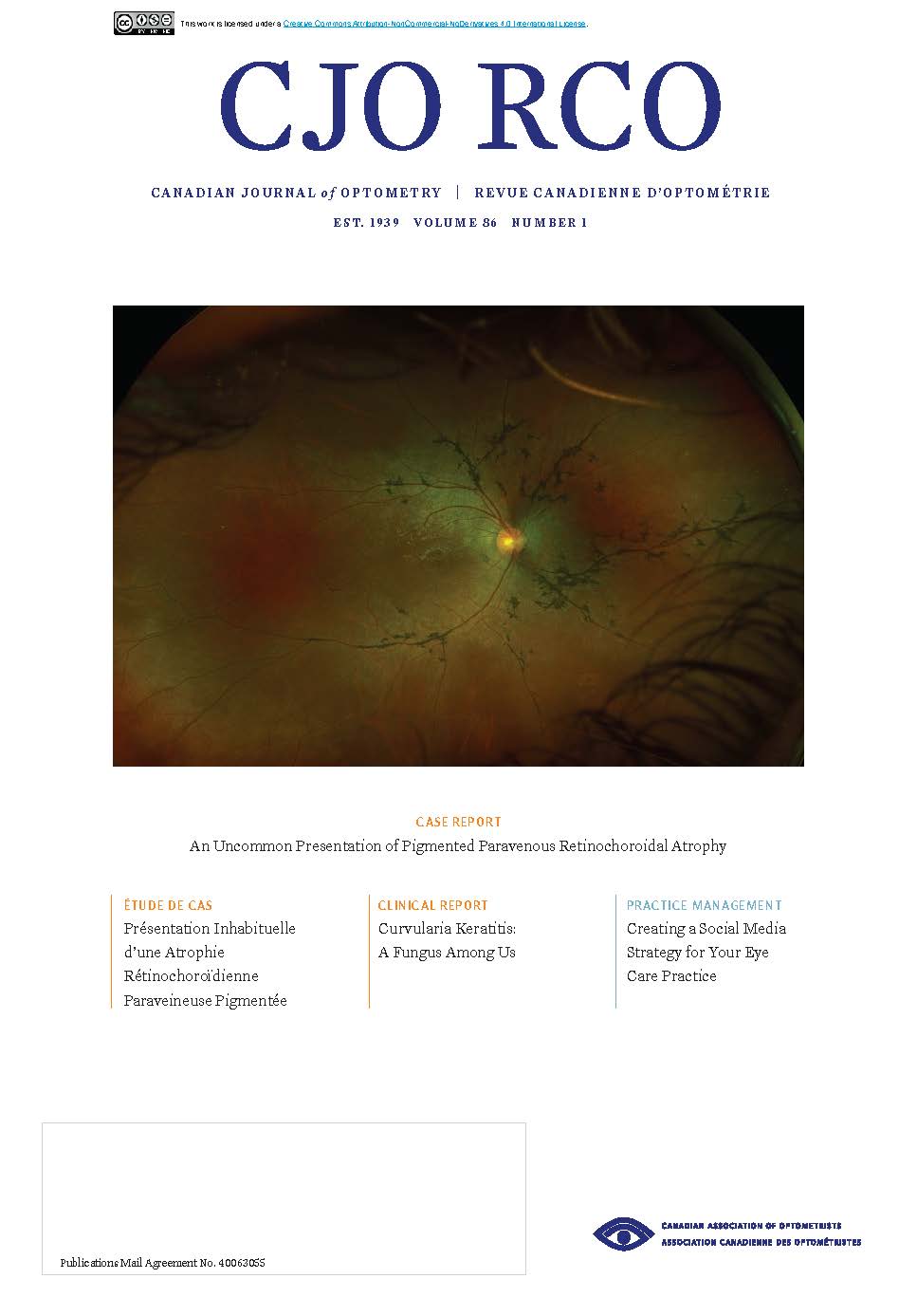Curvularia Keratitis: A Fungus Among Us
DOI:
https://doi.org/10.15353/cjo.v86i1.5565Keywords:
fungal keratitis, Curvularia, voriconazole, posaconazole, cultureAbstract
Purpose: This case demonstrates a less commonly encountered type of fungal keratitis caused by Curvularia species and highlights the current standard of care for fungal keratitis.
Case Report: A 48 year old Caucasian female is referred with a two week history of a red, painful, and blurry right eye. Feathery borders, white focally elevated infiltrate with an overlying epithelial defect, and satellite lesions led to a clinical diagnosis of fungal keratitis. Curvurlaria was determined by culturing to be the most likely causative organism. A review of fungal keratitis and treatment strategies based on susceptibility testing and evidence-based reasoning is discussed.
Conclusion: Fungal keratitis is a condition that can initially be misdiagnosed and delays in treatment can significantly affect visual outcomes. Combination of strong clinical knowledge, communication with local microbiology laboratories, and the ability to adjust treatment strategies during follow up can effectively manage this condition.
Key Words: Fungal keratitis, Curvularia, voriconazole, posaconazole, culture
References
Ung L, Bispo PJM, Shanbhag SS, Gilmore MS, Chodosh J. The persistent dilemma of microbial keratitis: Global burden, diagnosis, and antimicrobial resistance. Surv Ophthalmol. 2019;64(3):255-271. doi:10.1016/j.survophthal.2018.12.003
Sahay P, Singhal D, Nagpal R, et al. Pharmacologic therapy of mycotic keratitis. Surv Ophthalmol. 2019;64(3):380-400. doi:10.1016/j.survophthal.2019.02.007
Thomas PA, Kaliamurthy J. Mycotic keratitis: Epidemiology, diagnosis and management. Clin Microbiol Infect. 2013;19(3):210-220. doi:10.1111/1469-0691.12126
Keenan JD, Mcleod SD. 4.13 - Fungal Keratitis. Fifth Edit. Elsevier Inc.; 2019. doi:10.1016/B978-0-323-52819-1.00215-2
Prajna N V., Srinivasan M, Mascarenhas J, et al. Visual Impairment in Fungal Versus Bacterial Corneal Ulcers 4 Years After Successful Antimicrobial Treatment. Am J Ophthalmol. 2019;204:124-129. doi:10.1016/j.ajo.2019.03.010
Thomas PA. Fungal infections of the cornea. Eye. 2003;17(8):852-862. doi:10.1038/sj.eye.6700557
Brandt ME, Warnock DW. Epidemiology, Clinical Manifestations, and Therapy of Infections Caused by Dematiaceous Fungi. 2003.
Wilhelmus KR, Jones DB, Gottsch JD. Curvularia keratitis. Trans Am Ophthalmol Soc. 2001;99:111-132.
Manikandan P, Abdel-Hadi A, Randhir Y, et al. Antifungal Susceptibilities of Fusarium and Aspergillus Isolates from Corneal Scrapings. 2019;2019. doi:10.1155/2019/6395840
Durand ML. Bacterial and fungal endophthalmitis. Clin Microbiol Rev. 2017;30(3):597-613. doi:10.1128/CMR.00113-16
Stagner AM, Jakobiec FA, Eagle RC, Charles NC. Infections of the Eye and Its Adnexa. Diagnostic Pathol Infect Dis. 2018:648-685. doi:10.1016/B978-0-323-44585-6.00021-7
Scognamiglio T, Zinchuk R, Gumpeni P, Larone DH. Comparison of inhibitory mold agar to sabouraud dextrose agar as a primary medium for isolation of fungi. J Clin Microbiol. 2010;48(5):1924-1925. doi:10.1128/JCM.01814-09
Mahdy RA, Nada WM, Wageh MM. Topical amphotericin B and subconjunctival injection of fluconazole (Combination Therapy) versus topical amphotericin B (Monotherapy) in treatment of keratomycosis. J Ocul Pharmacol Ther. 2010;26(3):281-285. doi:10.1089/jop.2010.0005
Robinson J, Ellen J, Hadel B, Lighthizer N. Collecting a corneal culture. Review of Optometry. https://www.reviewofoptometry.com/article/collecting-a-corneal-culture. Published 2016. Accessed November 18, 2019.
Tang L, Yang XF, Qiao M, et al. Posaconazole vs. voriconazole in the prevention of invasive fungal diseases in patients with haematological malignancies: A retrospective study. J Mycol Med. 2018;28(2):379-383. doi:10.1016/j.mycmed.2017.11.003
Published
How to Cite
Issue
Section
License
Copyright (c) 2024 Sophia Leung

This work is licensed under a Creative Commons Attribution-NonCommercial-NoDerivatives 4.0 International License.


